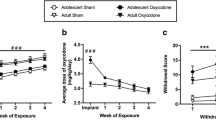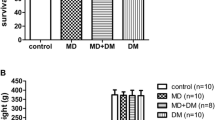Abstract
The effects of prenatal opioid exposure in adult animals has been widely studied, but little is known about the effects of prenatal opioid on adolescents. Most of the risk behaviors associated with drug abuse are initiated during adolescence. The developmental state of the adolescent brain makes it vulnerable to initiate drug use and susceptible to drug-induced brain changes. In this study, pregnant rats were subcutaneously injected with an increasing dose of morphine (5 mg/kg, 7 mg/kg, 10 mg/kg) for 9 days since the gestation day 11. The effects of prenatal morphine (PNM) on learning and memory, anxiety- and depressive- like behavior, morphine induced conditioned place preference (CPP) as well as locomotor sensitization were tested in both adolescent and adult rats. The results showed that: (1) PNM decreased anxiety-like behavior in both adolescent and adult female rats, but not males; (2) PNM decreased depressive-like behavior in adolescent but increased depressive -like behavior in adult females; (3) PNM increased low dose morphine induced locomotor sensitization in females; (4) PNM decreased tyrosine hydroxylase (TH) expression in the prefrontal cortex but decreased dopamine D1 receptor expression in the nucleus-accumbens (NAc) in female rats. These results suggested that PNM altered the emotional and addictive behavior mainly in female rats, with female rats being less anxiety and depressive during adolescence, but more depressive in adult, and more sensitive to low dose morphine induced locomotor activity sensitization, which might be mediated in part by the differential expression of the TH, dopamine D1 receptors in the female brain.











Similar content being viewed by others
Data Availability
The data that support the findings of this study are available from the corresponding author upon reasonable request.
References
Bastos FI, Schenker M (2016) Drug abuse and addiction from the public health standpoint. Cienc Saude Coletiva 21:5–5
Jackson L (2019) Opioid, dopamine, and GABA receptor addiction and mental health enriched genomic areas co-located with 16 cancer, immunity and Parkinson’s disease drug binding sites. Eur J Hum Genet 27:1687–1688
Buchi KF, Suarez C, Varner MW (2013) The Prevalence of Prenatal Opioid and Other Drug Use in Utah. Am J Perinat 30:241–244
Merhar SL, Kline JE, Braimah A, Kline-Fath BM, Tkach JA, Altaye M et al (2021) Prenatal opioid exposure is associated with smaller brain volumes in multiple regions. Pediatr Res 90:397–402
Radhakrishnan R, Brown BP, Haas DM, Zang Y, Sparks C, Sadhasivam S (2022) Pilot study of fetal brain development and morphometry in prenatal opioid exposure and smoking on fetal MRI. J Neuroradiol 49(1):53–58
Dholakiya SL, Aliberti A, Barile FA (2016) Morphine sulfate concomitantly decreases neuronal differentiation and opioid receptor expression in mouse embryonic stem cells. Toxicol Lett 247:45–55
Mansour A, Fox CA, Burke S, Akil H, Watson SJ (1995) Immunohistochemical localization of the cloned mu opioid receptor in the rat CNS. J Chem Neuroanat 8:283–305
Geladopoulos T, Sakellaridis N, Vernadakis A (1987) Differential maturation of mu and delta opioid receptors in the chick embryonic brain. Neurochem Res 12:279–288
Le Moine C, Fauchey V, Jaber M (2002) Opioid receptor gene expression in dopamine transporter knock-out mice in adult and during development. Neuroscience 112:131–139
Tan JW, Duan TT, Zhou QX, Ding ZY, Jing L, Cao J et al (2015) Impaired contextual fear extinction and hippocampal synaptic plasticity in adult rats induced by prenatal morphine exposure. Addict Biol 20:652–662
Slamberova R, Schindler CJ, Pometlova M, Urkuti C, Purow-Sokol JA, Vathy I (2001) Prenatal morphine exposure differentially alters learning and memory in male and female rats. Physiol Behav 73:93–103
Gholami M, Saboory E, Ahmadi AA, Asouri M, Nasirikenari M, Rostamnezhad M (2020) Long-time effects of prenatal morphine, tramadol, methadone, and buprenorphine exposure on seizure and anxiety in immature rats. Int J Neurosci 1–8
Nakhjiri E, Saboory E, Roshan-Milani S, Rasmi Y, Khalafkhani D (2017) Effect of prenatal restraint stress and morphine co-administration on plasma vasopressin concentration and anxiety behaviors in adult rat offspring. Stress 20:205–211
Abu Y, Roy S (2021) Prenatal opioid exposure and vulnerability to future substance use disorders in offspring. Exp Neurol: 339
Ahmadalipour A, Sadeghzadeh J, Vafaei AA, Bandegi AR, Mohammadkhani R, Rashidy-Pour A (2015) Effects of environmental enrichment on behavioral deficits and alterations in hippocampal BDNF induced by prenatal exposure to morphine in juvenile rats. Neuroscience 305:372–383
Ahmadalipour A, Ghodrati-Jaldbakhan S, Samaei SA, Rashidy-Pour A (2018) Deleterious effects of prenatal exposure to morphine on the spatial learning and hippocampal BDNF and long-term potentiation in juvenile rats: Beneficial influences of postnatal treadmill exercise and enriched environment. Neurobiol Learn and Mem 147:54–64
Buisman-Pijlman FT, Gerrits MA, Van Ree JM (2009) Increased opioid release in specific brain areas in animals exposed to prenatal morphine and emotional stress later in life. Neuroscience 159(1):405–413
Buchi KF, Suarez C, Varner MW (2013) The Prevalence of Prenatal Opioid and Other Drug Use in Utah. Am J Perinat 30:241–244
Melbourne JK, Chandler CM, Van Doorn CE, Bardo MT, Pauly JR, Peng H, Nixon K (2021) Primed for addiction: A critical review of the role of microglia in the neurodevelopmental consequences of adolescent alcohol drinking. Alcohol Clin Exp Res 45:1908–1926
Mp A, Jf A, Sh A et al (2020) Foundations of addictive problems in adolescents: Developmental and social factors – ScienceDirect. Adolescent Addiction (Second Edition), 2020:3–17
Wang MP, Ho SY, Lo WS, Lam TH (2012) Smoking family, secondhand smoke exposure at home, and nicotine addiction among adolescent smokers. Addict Behav 37:743–746
Prieto JP, González B, Muiz J et al (2020) Molecular changes in the nucleus accumbens and prefrontal cortex associated with the locomotor sensitization induced by coca paste seized samples. Psychopharmacology, 2020: 237–240
Paus T, Keshavan M, Giedd JN (2008) Why do many psychiatric disorders emerge during adolescence? Nat Rev Neurosci 9:947–957
Penninx BW, Pine DS, Holmes EA et al (2021) Anxiety disorders. Lancet: 397: 914–927
An X, Yao X, Li B et al (2021) Role of BDNF-mTORC1 Signaling Pathway in Female Depression. Neural Plast 2021:1–8
Vathy I, Rimanoczy A, Eaton RC, Katay L (1994) Modulation of catecholamine turnover rate in brain regions of rats exposed prenatally to morphine. Brain Res 662:209–215
Vathy I, He HJ, Iodice M, Hnatczuk OC, Rimanoczy A (2000) Prenatal morphine exposure differentially alters TH-immunoreactivity in the stress-sensitive brain circuitry of adult male and female rats. Brain Res Bull 51:267–273
Tillage RP, Foster SL, Lustberg D, Liles LC, McCann KE, Weinshenker D (2021) Co-released norepinephrine and galanin act on different timescales to promote stress-induced anxiety-like behavior. Neuropsychopharmacol 46:1535–1543
Bian YY, Yang LL, Wang ZL, Wang Q, Zeng L, Xu GH (2015) Repeated Three-Hour Maternal Separation Induces Depression-Like Behavior and Affects the Expression of Hippocampal Plasticity-Related Proteins in C57BL/6 N Mice, Neural Plast 2015: 627837
Szutorisz H, Dinieri JA, Sweet E et al (2014) Parental THC Exposure Leads to Compulsive Heroin-Seeking and Altered Striatal Synaptic Plasticity in the Subsequent Generation. Neuropsychopharmacology 39:1315–1323
Vassoler FM, Wright SJ, Byrnes EM (2016) Exposure to opiates in female adolescents alters mu opiate receptor expression and increases the rewarding effects of morphine in future offspring. Neuropharmacology 103:112–121
Nakhjiri E, Sh RM, Saboory E (2015) The effect of co-administration of restraint stress and morphine in prenatal period and re-exposure to stress at the end of infancy on corticosterone blood levels and pentylentetrazol-induced epileptic behaviors in rat. International Journal of Research in Applied and Basic Medical Sciences 2015; 1(1): 41–50
Reniers R, Murphy L, Lin A et al (2016) Risk Perception and Risk-Taking Behaviour during Adolescence: The Influence of Personality and Gender. PLoS ONE 11:e0153842
Steketee JD, Kalivas PW (2011) Drug wanting: behavioral sensitization and relapse to drug-seeking behavior. Pharmacol Rev 63(2):348–365
Becker Jill B, Koob George F (2016) Sex Differences in Animal Models: Focus on Addiction. Pharmacol Rev 68:242–263
Lovallo WR, King AC, Farag NH, Sorocco KH, Cohoon AJ, Vincent AS (2012) Naltrexone effects on cortisol secretion in women and men in relation to a family history of alcoholism: studies from the Oklahoma Family Health Patterns Project. Psychoneuroendocrino 37(12):1922–1928
Volkow ND, Morales M (2015) The Brain on Drugs: From Reward to Addiction. Cell 162:712–725
Funding
This work was supported by the National Natural Science Foundation of China (No. 81760251, 32060196) and the Yunnan high-level talent special support plan (YNWR-QNBJ-2018-026).
Author information
Authors and Affiliations
Contributions
Yanmei Chen designed the project, performed partial behavioral experiments, supervised the experiments, analyzed the data and wrote the manuscript; Miaomiao Du, Na Kang, Xin Guan and Bixue Liang performed the behavioral experiments;Zhuangfei Chen performed partial data analysis and revised the manuscript; Jichuan Zhang designed the project, supervised the experiments, performed partial data analysis, and revised the manuscript.
Corresponding authors
Ethics declarations
Conflict of Interest
The authors have no relevant financial or non-financial interests to disclose.
Ethical Approval
All experiments were conducted in accordance with the guidelines for National Care and Use of Animals approved by the National Animal Research Authority. Protocols were approved by the Medical Animal Care & Welfare Committee of Kunming University of Science and Technology (No. 2017JC002).
Additional information
Publisher’s Note
Springer Nature remains neutral with regard to jurisdictional claims in published maps and institutional affiliations.
Electronic Supplementary Material
Below is the link to the electronic supplementary material.
Rights and permissions
About this article
Cite this article
Chen, Y., Du, M., Kang, N. et al. Prenatal Morphine Exposure Differentially Alters Addictive and Emotional Behavior in Adolescent and Adult Rats in a Sex-Specific Manner. Neurochem Res 47, 2317–2332 (2022). https://doi.org/10.1007/s11064-022-03619-8
Received:
Revised:
Accepted:
Published:
Issue Date:
DOI: https://doi.org/10.1007/s11064-022-03619-8




